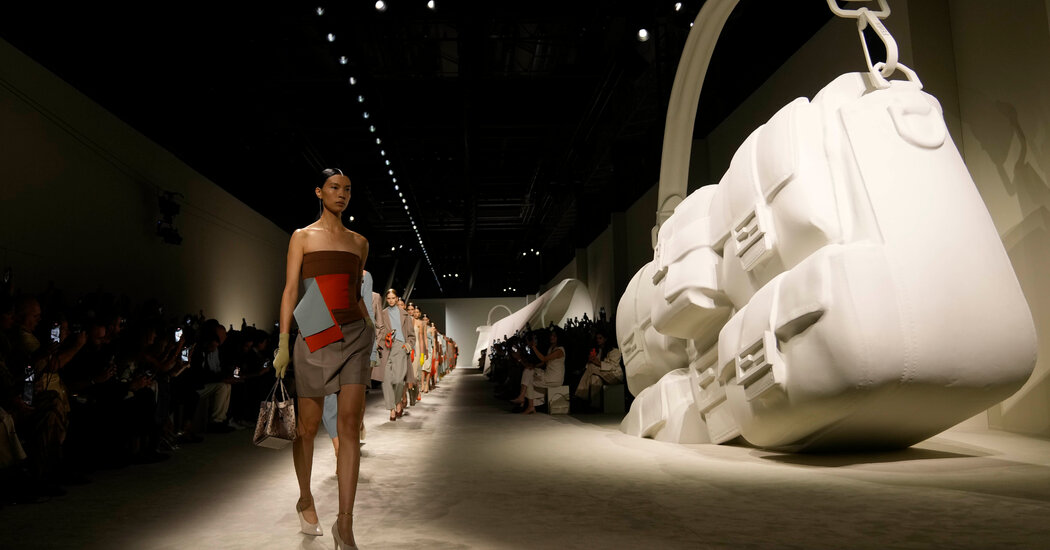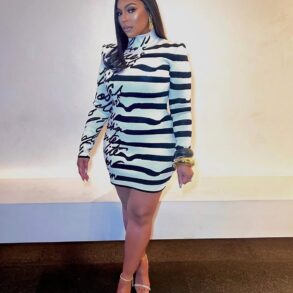
The weirdest, wildest and most wearable moments from the spring 2024 shows.
Fashion month — or the back-to-back fashion weeks in New York, London, Milan and Paris — is underway once again. Hundreds of shows will take place before it ends, not to mention dozens of parties. And for every look shown on the runways, there will be others worth noticing on the streets outside the spring 2024 shows.
It’s a lot to stay on top of, even for veteran attendees. For those not sure where to start, the following collection of articles is a guide to the most memorable shows, clothes and moments witnessed by Styles reporters, photographers and editors during fashion month. The fashion weeks in New York and London may be over, but Milan’s is still underway and Paris’s has yet to begin. We’ll be there reporting, reviewing — and adding to this list as we do.
Versions of Nostalgia at Tom Ford and Prada
The collections shown in Milan by Tom Ford and Prada were both inspired by the past. According to The Times’s chief fashion critic, Vanessa Friedman, one label’s use of nostalgia felt fresher than the other’s. Prada’s collection, which referenced the ’20s, ’30s, ’80s and ’90s, included iridescent organza shift dresses with wisps of material floating behind them and distressed oversize barn coats. The clothes seemed to remix history, rather than simply reproduce it, Vanessa wrote.
At Tom Ford, the first collection by Peter Hawkings, who earlier this year became creative director of the label after its eponymous designer stepped down, was a tour of Mr. Ford’s greatest, slinkiest and sexiest hits. But the homage felt less potent than the clothes that inspired it. As Vanessa put it, “Real seduction comes garbed in the confidence of an original point of view.”
Fendi Finds a Groove
Milan Fashion Week started on a high note: specifically, Fendi’s runway show, which Vanessa Friedman described as its best one since Kim Jones became the brand’s artistic director three years ago.
Why? Because Mr. Jones, for the first time, managed to create clothes that outshone the bags that for years have dominated the discourse about the brand. “They looked grown-up without looking stuffy; comfortable but also streamlined,” Vanessa wrote. “The same way you stuff your life into a handbag and feel pulled-together, you could stuff your self into these clothes and feel equipped to make some margin calls.”
Women in Red, Delicious Accessories and Drama
After taking in the shows, events and gossip from London Fashion Week, the Styles reporter Elizabeth Paton compiled a list of the standout moments this season. Red appeared to be the dominant color, with labels like 16Arlington, Chet Lo, JW Anderson, and Supriya Lele all incorporating it into their collections. Some of the best accessories came from Simone Rocha (platform Crocs encrusted with chunky crystals and pearls), and from Labrum, which, as part of a partnership with Adidas, showed Samba sneakers and rubber clogs printed with Nomoli figurines of Sierra Leone and Liberia.
The silliest drama was caused by Burberry’s takeover of the Bond Street tube station, where platform signs were changed to read “Burberry Street” during fashion week. The move, Elizabeth wrote, “baffled scores of tourists and foreigners, who missed their stops.”
Heavy Branding at Burberry
For his second Burberry show, the British designer Daniel Lee shifted away from items that seemed to cater to Gen Z-ers and moved his attention to the grown-ups, Vanessa Friedman wrote.
Burberry’s classic trench featured prominently in the collection, she wrote, and “a print featuring the brand’s hardware — chains and locks and carabiners — snaked itself over silk shirts and scarf dresses, the backs of leather coats, and trousers.” The show was a strong showcase of branding, according to Vanessa, but the clothes lacked emotional depth.
Vogue Celebrates British Fashion
Last September, Anna Wintour and a small army of Vogue staff members, models and celebrities staged a fashion spectacle in Manhattan’s meatpacking district. This month Ms. Wintour — along with stars like Leonardo DiCaprio, Kate Winslet and Sienna Miller, and British royals like the Princesses Beatrice and Eugenie — did it again, in London.
The Vogue World event, which took place in the city’s Theater Royal in Drury Lane, was designed to support London’s performing arts and celebrate its heritage as a cultural powerhouse, Elizabeth Paton wrote. But it was also designed to generate revenue for Vogue and its parent company, Condé Nast. “Ms. Wintour is betting on events like this one to bring plenty of sponsors and patrons willing to pay for one-night-only access to the starry Vogue universe,” Elizabeth wrote.
Top Talent Cancels London Show
The Turkish-British designer Dilara Findikoglu, whose show was one of the most anticipated at London Fashion Week this season, surprised many in the industry when she canceled it just days before it was set to take place. Ms. Findikoglu, whose gowns have been worn on red carpets and featured in magazines, told Elizabeth Paton that she called off the show because she didn’t have the money to stage it.
“I love what I do, and I wouldn’t want to do anything else,” Ms. Findikoglu said. “But I want people to know that it’s a backbreaking, soul-crushing struggle to be an independent designer in 2023. This is no fairy tale. Anyone who says otherwise is lying.”
A Street Style Shift in New York
While documenting the style outside the New York Fashion Week shows, the photographer Simbarashe Cha wondered if individuality was going out of fashion. There wasn’t an absence of stylish people, he wrote, but risk-takers seemed to be in shorter supply.
Among the more interesting clothes Simbarashe saw on the streets were women’s suit jackets with the shape of an inverted triangle and many items with fringe, which, he wrote, suggested “the dawn of a new era for urban cowboys.”
Versions of a Post-Pandemic Wardrobe
In the two years since the pandemic lockdowns ended, fashion has been all over the map. But this season, some designers in New York offered their clearest vision yet for post-pandemic dressing. Vanessa Friedman called it “a hybrid look for a hybrid world.” At Tory Burch, sleeves of no-nonsense suit jackets were sliced open to free forearms. Michael Kors showed empire-waist dresses with leotard tops and airy skirts.
Lightness also characterized the clothes at Gabriela Hearst (a cotton trench with chiffon inserts hidden between its pleats) and at Carolina Herrera (a lemon yellow skirt constructed from four layers of tulle but no crinolines). According to Vanessa, however, “no designer did more to crystallize the way forward than Willy Chavarria, whose genderless suiting deserves to redefine New York fashion.”
A Melting Pot of Fashion
The designers at New York Fashion Week reflect the diverse demographics of the city. There are titans and hustlers, stalwarts and upstarts, dreamers and pragmatists. And the clothes shown by many labels — Coach, Ralph Lauren, Collina Strada and Fforme among them — could be described as camouflage that nodded to those many identities, according to Vanessa Friedman.
Ekhaus Latta, Vanessa wrote, assembled a D.I.Y. army “in oily, touchable jeans, fuzzy knits and patchworks of transparent organza.” Proenza Schouler, she wrote, “focused on the essentials,” which included a jacket in duck-egg blue over low-slung trousers. Other collections, though they had a clear identity, were less original. “It was impossible to see the battering-ram shoulders of the leather jackets and trenches” on the runway at Khaite, Vanessa wrote, “and not think of Saint Laurent from last season.”
Ten Years of New York Men’s Day
The 10th installment of New York Men’s Day, a showcase of men’s wear collections during New York Fashion Week, featured presentations from the labels Kent Anthony, which showed sharply outlined jackets with beaded hems; Raleigh Denim Workshop, which makes jeans that have been worn by Brad Pitt; and A. Potts and the Salting, both of which describe their clothes as genderless.
Guy Trebay, The Times’s men’s wear critic, said that the clothes didn’t exactly startle with breadth of vision or design chops. But the presentations did show promise, he wrote, by offering “a generalized sense that the juggernaut of consolidation, corporatized fashion and a diminishing bricks-and-mortar retail scene won’t be enough to deter designers.”
Anna Delvey Brings the Runway to Her Rooftop
As New York Fashion Week has transformed from an industry trade show into a pop-cultural event, runways have been set up at all sorts of unusual venues. But few locations have been as unconventional as that of the brand Shao’s debut show, which was co-hosted by Anna Sorokin (a.k.a. Delvey), the fake German heiress, on the rooftop of the East Village building where she is under house arrest.
Vanessa Friedman said the theory behind the venue choice was simple: “The fashion world would come for the novelty of gawking at the co-host,” she wrote. “And if they came, they’d have to see the clothes.”
For Ralph Lauren, a Proven Formula
The designer Ralph Lauren has said he has never liked fashion. And yet for 56 years he has been a player in the industry. According to Jessica Testa, a Times reporter of fashion news, Mr. Lauren has maintained his influence on American fashion through a combination of familiarity and desire. His spring 2024 show and the dinner that followed were the latest examples of this formula.
Both took place at a venue made to recall Mr. Lauren’s Colorado ranch, with a familiar faux-worn wooden framework and intentionally mismatched white chairs. And both were attended by desirable guests, including Julianne Moore, Jennifer Lopez, Diane Keaton and Amanda Seyfried, who, Jessica wrote, were “seated shoulder to shoulder like the world’s most enviable group of girlfriends.”
A New Designer at Helmut Lang
For many, the most the most anticipated show of New York Fashion Week was Helmut Lang, where the designer Peter Do presented his first collection for the label beloved in the 1990s for its cool minimalism. (Ahead of the show, Jessica Testa profiled Mr. Do.)
Vanessa Friedman wrote that Mr. Do had clearly done his research to prepare for his debut. “That, it turned out, was the problem,” she wrote. While his collection had “Helmut Easter eggs” — like flat-front pants, Crombie coats and lacquered jeans — it didn’t exactly propel the label forward.
The Victoria’s Secret Show, Reborn
Among the first events at New York Fashion Week this season was a new version of an old spectacle: The Victoria’s Secret Fashion Show, which had not been staged since 2018. Instead of parading models down a runway, the lingerie brand, which has moved away from making clothes to attract the male gaze, showed a trailer for “The Victoria’s Secret World Tour,” a feature-length film debuting this month on Amazon Prime.
The film, which showcases the work of four female creatives, is intended to be the final step in Victoria’s Secret’s quest to “become the world’s leading advocate for women,” as the brand has put it. Vanessa Friedman gave a middling review. “It’s not enough, in the end, for a brand to simply say it stands for ‘women,’” she wrote. “It has to offer up a coherent point of view on women and what it thinks women need.”
Melissa Guerrero contributed writing.
This post was originally published on this site be sure to check out more of their content.








